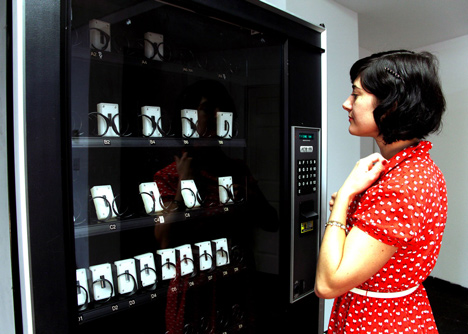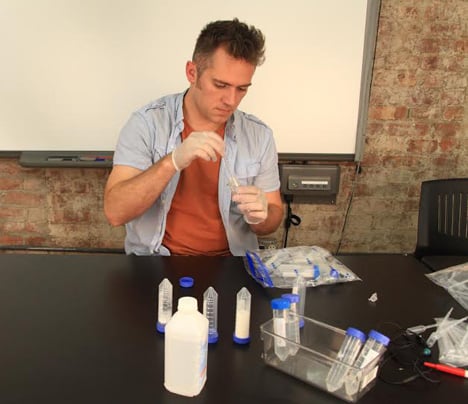Genetic engineering will be "as accessible as 3D-printing" says DNA Vending Machine designer
Artist Gabriel Barcia-Colombo has created a vending machine that dispenses human genetic material to highlight privacy issues emerging as biotechnology makes it easier and cheaper to access information locked in our DNA (+ interview).
"In a dystopian future where we all have samples of our friends' DNA, we will be able to do things like genetic engineering in the same way as we do 3D printing," Gabriel Barcia-Colombo told Dezeen. "When everyone has access to cheaper biotechnology, DNA may be much more valuable than a candy bar, soda or some other treat sold in a vending machine."
The New York artist created the DNA Vending Machine with the hope of challenging people to ask more questions about privacy and who owns the material that makes us unique.
"There are a whole range of court cases that say our DNA can be used against us for anything," explained the artist, who is also a lecturer at New York University specialising in interactive telecommunications. "We have huge pharmaceutical companies making loads of money out of DNA from people who haven't necessarily given them permission to use it."

Presented in a recent TED Talk, the DNA Vending Machine replaces snacks and drinks usually found in an automated food dispenser with samples of people's genetic code. These samples can then be bought.
"I began collecting the DNA of my friends at my house during Friday night gatherings, and then furthered mycollection through several scheduled open houses where anyone could come to my studio and sign up to submit an open-source sample of their own DNA," the artist explained.
Participants in the project spat into a vial containing solution that breaks down the cells found in the saliva, releasing the DNA. Alcohol was then added, causing the strands of genetic code to clump together and making them visible to the human eye.
The vials were then sealed inside identical white containers and placed inside a standard vending machine. "Each sample comes packaged with a collectable portrait of the human specimen as well as a unique link to a custom DNA extraction video," said Barcia-Colombo.
The machine was installed in an art gallery in New York last year, and the artist recalls some of the reactions to the art piece. "They're disgusted that this is using human genetic material, and they often are scared by it," he said. "They're scared because the samples can be bought and used to plant evidence on a crime scene."
"In a dystopian future where we all have samples of our friends' DNA, we will be able to do things like genetic engineering in the same way as we do 3D printing," he predicted. "When everyone has access to cheaper biotechnology, DNA may be much more valuable than a candy bar, soda or some other treat sold in a vending machine."
Barcia-Colombo sees comparisons between DNA ownership and concerns over the collecting and harvesting of our own digital data. “Our phones are harvesting our data and then being sold is a very similar idea to companies harvesting our DNA and selling it to pharmaceutical companies without us knowing."
The DNA Vending Machine was designed to start a conversation that the artist feels is long overdue.

One of the most high-profile cases surrounding the legality and ethics of DNA ownership was the example of Henrietta Lacks. While receiving treatment for cancer of the cervix in 1951, she had a healthy part of the tissue removed without permission.
The cells were later grown in vitro and have since been used by pharmaceutical companies to develop polio vaccines and in the research of AIDS, cancer and radiation poisoning. The material is still used today and is referred to as hela cells in reference to the first two letters of her first and last name.
More recently, a court case in 1990 between John Moore, a US citizen undergoing treatment for hairy cell leukaemia and the UCLA Medical Center brought the issue back into the headlines. "The supreme court decision in the case ruled that a person's discarded tissue and cells are not their property and can be commercialised," said Barcia-Colombo. "It's ridiculous. When it becomes easy to reproduce these things, it brings up a lot of personal questions about rights and you as a personal franchise."
A second version of the art project is due to go on display in New York this summer.
Below is an edited transcript of the interview with Barcia-Colombo:
Matt Hussey: How did you develop the idea of the vending machine?
Gabriel Barcia-Colombo: I'm very interested in the idea of law generally when it comes to ownership of DNA, and I like to express that in a playful way. But it's really about questions of privacy. We have huge pharmaceutical companies making loads of money out of DNA from people who haven't necessarily given them permission to use their DNA. That kind of thing really fascinates me.
Matt Hussey: What is the piece about?
Gabriel Barcia-Colombo: The piece is about privacy and DNA ownership. With the DNA Vending Machine I hope to draw attention to historical cases of DNA ownership or commercialised human cells as in the cases of Henrietta Lacks and the supreme court decision in Moore v. Regents of the University of California, where in the early 1990's the court ruled that a person's discarded tissue and cells are not their property and can be commercialised.
This is not a celebration of any of these verdicts or laws but rather a reminder of our complicated past when it comes to ownership over genetic material. In the future, when everyone has access to cheaper biotechnology, DNA may be much more valuable than a candy bar, soda or some other treat sold in a vending machine.
Matt Hussey: What have been the responses to the vending machine?
Gabriel Barcia-Colombo: On approaching it, they don't know what it is. Then they read about it on a little placard and are pretty grossed out by it. They're disgusted that this is using human genetic material, and they often are scared by it.
They're scared because the samples can be bought and used to plant evidence on a crime scene. It's DNA from inside our cheek cells which is very readily available, but in this context it's elevated to a more artistic context, but also, in another way, it makes it more human.
Matt Hussey: Who are the samples of?
Gabriel Barcia-Colombo: Mostly friends. I started doing it at parties. I'd have people over at my house and say hey, "let's do some DNA extraction" and show them how it worked. I work at NYU and asked if there were any students who would be interested in it outside NYU, and then I worked with a bio-tech lab in Brooklyn called Genspace, and we did some DNA extractions there. So I started with friends and then expanded."
Matt Hussey: Were you worried at all that people wouldn't want to give samples?
Gabriel Barcia-Colombo: I was worried at first about how many people would want to be part of it. I explained to them very clearly that this could have implications where someone could buy this sample and if they wanted to sequence it, and in the process discovered some kind of new drug, they could make a lot of money out of this.
But I also framed it as a very exciting art project that they could be part of. I think it's one of the first times this has been done in the artistic community.
Matt Hussey: What was it that appealed to you about using a vending machine?
Gabriel Barcia-Colombo: They're usually utilised to sell snacks at the movie theatre or on the street, but suddenly here it's used to sell genetic material. It's funny in a way. Because it's humorous I think it makes it easier for people to understand. Ideally I'd want to bring it in to public places like Grand Central Station or Times Square. Places with a more public context.
Matt Hussey: There has been an increase in cheap gene sequencing thanks to companies like 23andMe that's raising legal questions that many people don't feel comfortable with. Is this a response to that?
Gabriel Barcia-Colombo: For me, it's indicative of other privacy right issues that are going on right now in the United States with phone calls and online data. When this moves completely into the genetic market, and when it becomes easy to reproduce these things, it brings up a lot of personal questions about rights and you as a personal franchise.
It also touches upon those people who are disenfranchised with the process and don't understand the legal issues surrounding it and don't have a way of really fighting back.
Matt Hussey: How would you summarise the mood of people towards these ideas?
Gabriel Barcia-Colombo: I think there is an immediate fear growing within people. I think we've only really started hearing about in the past two years. Our phones are harvesting our data and then being sold. It's a very similar idea to companies harvesting our DNA and being sold to pharmaceutical companies without us knowing. I think it's reflecting itself.
I myself am not a paranoid person, I'm very open about things, but I do think there is a place for art to question what is going on. I use art to provoke conversation, and this is a conversation piece. The DNA vending machine is not a protest piece, it's about having ideas and questioning what the future holds, security in terms of genetic material, and to educate people about what can be done with DNA, and how accessible this human data is.